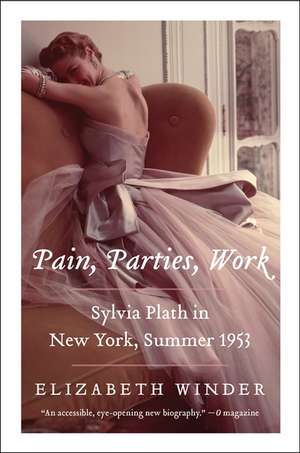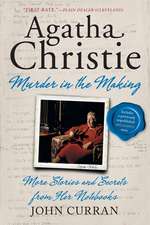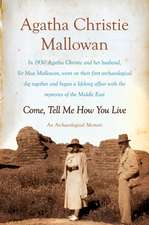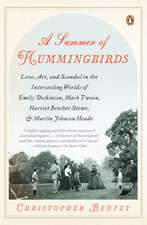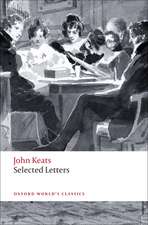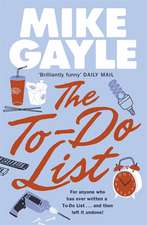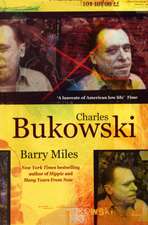Pain, Parties, Work: Sylvia Plath in New York, Summer 1953
Autor Elizabeth Winderen Limba Engleză Paperback – 31 mar 2014
In May of 1953, a twenty-one-year-old Plath arrived in New York City, the guest editor of Mademoiselle’s annual College Issue. She lived at the Barbizon Hotel, attended the ballet, went to a Yankee game, and danced at the West Side Tennis Club. She was supposed to be having the time of her life. But what would follow was, in Plath’s words, twenty-six days of pain, parties, and work, that ultimately changed the course of her life.
Thoughtful and illuminating, featuring line drawings and black-and-white photographs, Pain, Parties, Work: Sylvia Plath in New York, Summer 1953 offers well-researched insights as it introduces us to Sylvia Plath—before she became one of the greatest and most influential poets of the twentieth century.
Preț: 105.36 lei
Nou
Puncte Express: 158
Preț estimativ în valută:
20.16€ • 21.12$ • 16.67£
20.16€ • 21.12$ • 16.67£
Carte disponibilă
Livrare economică 21 martie-04 aprilie
Preluare comenzi: 021 569.72.76
Specificații
ISBN-13: 9780062085559
ISBN-10: 0062085557
Pagini: 288
Dimensiuni: 135 x 203 x 16 mm
Greutate: 0.2 kg
Editura: HarperCollins Publishers
Colecția HarperPerennial
ISBN-10: 0062085557
Pagini: 288
Dimensiuni: 135 x 203 x 16 mm
Greutate: 0.2 kg
Editura: HarperCollins Publishers
Colecția HarperPerennial
Textul de pe ultima copertă
On May 31, 1953, twenty-year-old Sylvia Plath arrived in New York City for a one-month stint as a guest editor for Mademoiselle magazine. Over the next twenty-six days, she lived at the Barbizon Hotel, attended Balanchine ballets, watched a game at Yankee Stadium, and danced at the West Side Tennis Club. She typed rejection letters to writers from The New Yorker and ate an entire bowl of caviar at an advertising luncheon. She stalked Dylan Thomas and fought off a diamond-wielding suitor from the United Nations. She took hot baths, had her hair done, and discovered her signature drink (vodka, no ice). Young, beautiful, and on the cusp of an impressive career, she was supposed to be having the time of her life.
Drawing on in-depth interviews with fellow guest editors, whose memories infuse these pages, Elizabeth Winder reveals how these twenty-six days indelibly altered how Plath saw herself, her mother, her friendships, and her romantic relationships, and how this period shaped her emerging identity as a woman and as a writer. Thoughtful and illuminating, Pain, Parties, Work offers new insight as it introduces us to Sylvia Plath, the girl, before she became one of the greatest and most influential poets of the twentieth century.
Drawing on in-depth interviews with fellow guest editors, whose memories infuse these pages, Elizabeth Winder reveals how these twenty-six days indelibly altered how Plath saw herself, her mother, her friendships, and her romantic relationships, and how this period shaped her emerging identity as a woman and as a writer. Thoughtful and illuminating, Pain, Parties, Work offers new insight as it introduces us to Sylvia Plath, the girl, before she became one of the greatest and most influential poets of the twentieth century.
Recenzii
“An illuminating biography . . . which floods clarifying light on a chapter of the poet’s early life that Plath painted in jaundiced tones in The Bell Jar.” — New York Times, Sunday Styles Feature
“The world of ’50s NYC, in all its glamour, is irresistible reading.” — Meg Wolitzer, author of The Interestings
“Will recalibrate your mind and heart. . . . We knew about Plath’s ambition - and angst - but her penchant for flaming-red lipstick and princess heels was a bit of a surprise” — More magazine
“A pixilated gem of a book. . . . In prose as delightful and lively as the champagne Sylvia liked to sip at the St. Regis ball, Winder has made Pain, Parties, Work a prose poem of the senses, and a true account of The Bell Jar.” — Sam Kashner and Nancy Schoenberger, New York Times bestselling authors of Furious Love
“A lovingly detailed inventory, as Technicolor-vivid as a Douglas Sirk film, of the fashions and foods that filled Plath’s summer. Winder convincingly shows that Plath should be recognized as much for her enjoyment of life and her enduring works as for her tragic death.” — Publishers Weekly
“Winder poignantly captures a snapshot of a time that directly inspired one of Plath’s most famous works. She also captures Plath as bright, vivacious . . . For fans, particularly devotees of The Bell Jar.” — Library Journal
“Winder resuscitates a young woman who, while sick, is electrically alive to her first real adventure. . . . Captivating . . . [Winder] makes a compelling argument that in New York…Plath moved closer to finding the voice that would define her writing.” — Slate
“Winder describes the aesthetics of the era beautifully. . . . Reading this book sparks feelings of impossible nostalgia for someone who didn’t live through the fifties; in this way, it is an experience akin to watching Mad Men.” — Bookslut
“The book offers a new perspective on Plath’s life courtesy of Winder’s exhaustive research.” — Women's Wear Daily
“Winder has painstakingly sketched a fully fleshed out portrait of Plath’s life during that hot, seminal summer, offering a glimpse into the raison d’etre behind Plath’s revered 1963 roman a clef, The Bell Jar. . . . Winder goes into the dizzying, delightful detail.” — USA Today
“[An] accessible, eye-opening new biography.” — O Magazine
“The world of ’50s NYC, in all its glamour, is irresistible reading.” — Meg Wolitzer, author of The Interestings
“Will recalibrate your mind and heart. . . . We knew about Plath’s ambition - and angst - but her penchant for flaming-red lipstick and princess heels was a bit of a surprise” — More magazine
“A pixilated gem of a book. . . . In prose as delightful and lively as the champagne Sylvia liked to sip at the St. Regis ball, Winder has made Pain, Parties, Work a prose poem of the senses, and a true account of The Bell Jar.” — Sam Kashner and Nancy Schoenberger, New York Times bestselling authors of Furious Love
“A lovingly detailed inventory, as Technicolor-vivid as a Douglas Sirk film, of the fashions and foods that filled Plath’s summer. Winder convincingly shows that Plath should be recognized as much for her enjoyment of life and her enduring works as for her tragic death.” — Publishers Weekly
“Winder poignantly captures a snapshot of a time that directly inspired one of Plath’s most famous works. She also captures Plath as bright, vivacious . . . For fans, particularly devotees of The Bell Jar.” — Library Journal
“Winder resuscitates a young woman who, while sick, is electrically alive to her first real adventure. . . . Captivating . . . [Winder] makes a compelling argument that in New York…Plath moved closer to finding the voice that would define her writing.” — Slate
“Winder describes the aesthetics of the era beautifully. . . . Reading this book sparks feelings of impossible nostalgia for someone who didn’t live through the fifties; in this way, it is an experience akin to watching Mad Men.” — Bookslut
“The book offers a new perspective on Plath’s life courtesy of Winder’s exhaustive research.” — Women's Wear Daily
“Winder has painstakingly sketched a fully fleshed out portrait of Plath’s life during that hot, seminal summer, offering a glimpse into the raison d’etre behind Plath’s revered 1963 roman a clef, The Bell Jar. . . . Winder goes into the dizzying, delightful detail.” — USA Today
“[An] accessible, eye-opening new biography.” — O Magazine
